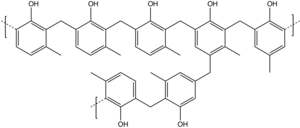Novolak
Novolaks (sometimes: novolacs) are low molecular weight polymers derived from phenols and formaldehyde. They are related to Bakelite, which is more highly crosslinked. The term comes from Swedish "lack" for lacquer and Latin "novo" for new, since these materials were envisioned to replace natural lacquers such as copal resin.

Typically novolaks are prepared by the condensation of a mixture of p- and m-cresol with formaldehyde (as formalin). The reaction is catalyzed by acid. Oxalic acid is often used because it can be subsequently removed by thermal decomposition. Novolaks have a degree of polymerization of approximately 20-40. The branching density, determined by the processing conditions, m- vs p-cresol ratio, as well as CH2O/cresol ratio is typically around 15%.[1]
Novolaks are especially important in microelectronics where they are used as photoresist materials.[2][3]
References
- Ralph Dammel (1993). "Basic Chemistry of Novolaks". Diazonaphthoquinone-based Resists. Int. Soc. Optical Engineering. ISBN 9780819410191.
- W. D. Hinsberg, G. M. Wallraff. (2005), "Lithographic Resists", Kirk-Othmer Encyclopedia of Chemical Technology, New York: John Wiley, doi:10.1002/0471238961.1209200808091419.a01.pub2, ISBN 9780471238966
- Chemical Information Review Document for Diazonaphthoquinone Derivatives Used in Photoresists, National Toxicology Program, January 2006